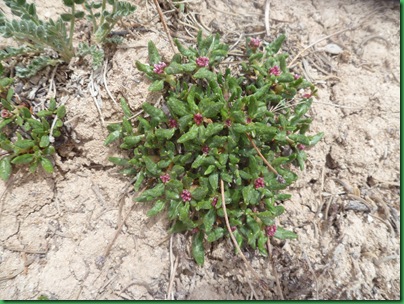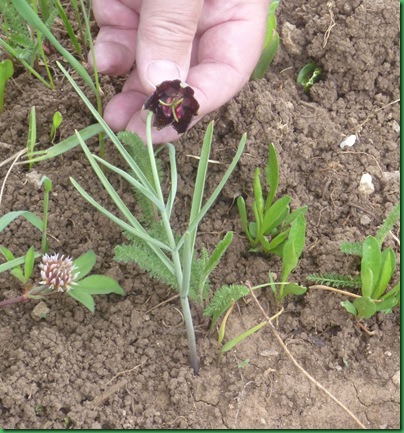Friday July 8, 2011
Cedar Breaks National Monument
Brian Head, Utah
David here again.
The Wildflower Festival began today and runs through July 24th.
Each day a volunteer naturalist will lead two walks (10 AM and 1 PM)
in various places and talk about the wildflowers in bloom
or coming up.
It is early spring here with the snow just melted,
well mostly.
Today's walks were led by LeRoy Kuehl,
a local resident amateur naturalist who was very knowledgeable.
He led both talks and said they would both be about the same.
Meet Leroy.
I went on the 10 AM walk and Sherry was to come catch up
and join the walk.
She was trying to publish a blog post on our
sketchy internet signal, but she never made it.
She did go for the afternoon walk and I went along
to see if he really would give the same talk.
Of course he didn't, but he did mostly talk about the same plants.
Here are some of the more prominent wildflowers
he introduced us to.
The first group are woodland plants.
Aspen bluebells are probably the most obvious
and numerous here now,
and they are gorgeous,
all smiling as if this is their happy place.
They grow without flowers for a couple of seasons
before they begin flowering,
and then bloom every year after.
Most wildflowers here, including the bluebells
are perennials due to the short growing season.
Their roots can be up to 7 feet deep!
And they really are EVERYWHERE here
in great profusion.
Colorado columbine - the state flower of Colorado,
is usually blue in Colorado, but most of them here are white.
Since they are the same exact species
this is probably due to local climate variations.
Their nectar is at the bottom of the long spurs on the back,
so it takes a hummingbird or butterfly with a long tongue
to reach in there.
Scarlet Paintbrush
- the red is actually leaves
and the real flower is tiny and yellow inside the leaves.
These plants are hemi-parasitic,
stealing nutrients from neighboring root systems.
The broad leaf spread below is elkweed.
They too take several seasons to develop
before they produce a large stalk loaded with flowers
in their final season and then they die.
This picture shows a past stalk
with a new plant staring out from seed,
probably in its first season.
Here is another in bloom.
And here is the colorful flower.
Isn’t that just amazing.
No wonder the plant dies after
such a huge show on this giant stalk.
Southern lagusticum, source of lagustamine,
has a root that is sold as osha root,
an herbal vasodialator used in China
but still being studied in the US.
It produces an alkaloid that makes it distasteful
to foraging animals.
The Alpine Prickly Current has tiny red trumpet flowers
and an edible berry that would need a lot of sugar
to be considered tasty.
It does have prickers on the stems.
This tiny Canada violet has fine pink stripes
that serve to direct its pollinators to the target
like landing lights at an airfield.
We moved out to the high rim or ridge
of the amphitheater where the ground drops off abruptly
and winds can be severe,
hence not many tall things here,
mostly short, squat and close to the ground.
Cushion phlox is squat, right down on the ground
and is the first wildflower I used in the Bryce Canyon
Peek-a-boo trail blog
- except in that picture all the petals were spent.
Here they are smiling.
False Solomon Seal
- same name as in Virginia but smaller
and with a different terminal flower.
Two TINY endemics (grow only here-nowhere else in the world)
are the Cedar Breaks gilia,
and the Panguitch buckwheat.
He did talk about some of the common trees here,
but for simplicity I will stick to the wildflowers.
Next is the buffalo berry,
used to season dried buffalo by the native peoples.
Twinberry got its name from the flowers that it produces in pairs
which then of course have berries in pairs.
Finally the tiny Fendler's sandwort
which appears to have a tiny maroon dot on each petal,
however closer examination shows
they are actually the head on the stamen.
After a short break,
he took us down another trail back toward the campground
to see some common meadow and bog wildflowers.
This is a lovely quarter mile connector trail
between the campground and the visitor center.
In the meadow first we saw quaking aspen,
but that is a tree, so I won't tell you about that.
How about this groundsel?
This gets very thick in other places
(check back tomorrow for a field of them).
A female meadow rue.
He could not locate a male plant,
but it looks similar except its flowering parts hang down, not up.
Leopard lily is about 3 inches tall
and the flower hangs upside down,
so it was turned up for us to see the unusual
almost brown but maroon petals!
The bog flowers he showed us were
plantain leaf buttercup (10 petals),
the pretty purple shooting star,
and the trout lily, not yet in bloom.
That is a total of 23 wildflowers
and already more than one could hope to learn in a day,
so he let us go.
We being gluttons for information local to where we are living
went on to the 4 o'clock ranger program at Point Sublime
on the subject of Mountain Lions and Bobcats in the park.
This talk was presented by another volunteer ranger
from a local college down in the town of Cedar Breaks, Jason Cosby.
He was quite knowledgeable, but we had to ask a lot of questions
so he would have something new to learn when he goes back to school at Southern Utah University in the fall.
He was a very good speaker and excellent with the many children.
Most important information was what to do and not to do
if we should encounter a big cat.
Normally they will not bother people,
but there are situations where they could,
like extreme hunger
or you being between them and their young.
Children are more likely targets when separated from parents.
So keep your children near when in their territory.
What to do:
Look BIG,
arms up and hold out your jacket or shirt tail
to make your profile as large as possible.
Do not appear to be fearful,
do not turn your back,
do not lose eye contact
never turn your head to the side and show the cougar your neck
and DO NOT run away.
Running will make you dinner for sure.
LOUD noises may help.
If you have to fight,
try to get on their backs and they will skedaddle
and you should at least survive
if a little worse for the experience.
But think of the stories you could tell about it.
This bobcat was a road kill and obtained with permission
of the Utah Game Commission for educational purposes
since most folks will not get the chance to see one in the wild.
Although we did see one on the AT in Virginia
but that’s a story for another day.
After the talk and back in the coach for dinner,
we were treated to two sets of hailstorms
in combination with a thunderstorm
and a good deal of heavy rain.
In our backyard….
Poor Ruby again….but at least smaller hail this time
Normally I would have skipped the evening ranger program
after already having been to three others,
but tonight ranger Steven Kroff told me
he would be speaking about "Life in the CCC"
using information based on his own grandfather's experience
in this area.
Couldn't miss that.
Due to the rain, the program was moved
from the outdoor amphitheater near the campground
to the Visitor Center
- a small, well preserved CCC log cabin!
How perfect a setting!
Here is Steve earlier in the day in front of the visitor center.
And sweeter still was this sunset at Point Sublime,
right by the Visitor Center.
Some slides from Steve's talk.
This is the fire lookout the CCC built on Brian's Head peak,
which is still there today
and still in great condition considering its age.
Also I learned that one team of CCC came from Zion,
and they had built the South Campground Amphitheater
there which is still in use today.
The slide before this showed the men with shovels and picks
leveling this entire area by hand - no power anything.
Enough CCC for today,
it is also on the schedule tomorrow night,
different speaker and look at the CCC.
You know I’ll be there ! ;{)


































That was one "waffled" Bobcat! Cool that they preserved its hide to show folks.
ReplyDeleteLove hearing about the CCC, too. Just amazing what those guys did with next to nothing in the way of tools and lots of muscle power.
Just catching up with my reading again. Great pictures as always. I'll bet that hail was a little loud in the MH. Stay safe.
ReplyDeleteSyl
Wow, what a wonderful day!! Sure glad our future tour guides are learning all these great things;o))
ReplyDeleteThanks for taking us along:o))
Great tour as always. Thanks for the info on what to do if I ever encounter a big cat. Hopefully I won't ever have to jump on the back of one, forcing it to run away from me in fear. ;-)
ReplyDeleteLove the wild flowers and your photography is great! That info about the bobcats/mountain lion is useful and I pray that I'll never have to use it. Oh me. I saw a bobcat one night up on Skyline Drive when I was first year of college. At least 10 of us were in a friend's Cadillac (what 18-year-old guy had a Cadillac?) and one ran across the road. It was a "What was that?!?" moment. I was lucky enough to be in the front seat to see it, but it took me a few seconds to realize what I had just seen. That's the only way I want to see another one -- me in my natural habitat -- a car-- and the bobcat in his! Love the posts. Thank you so much!
ReplyDelete